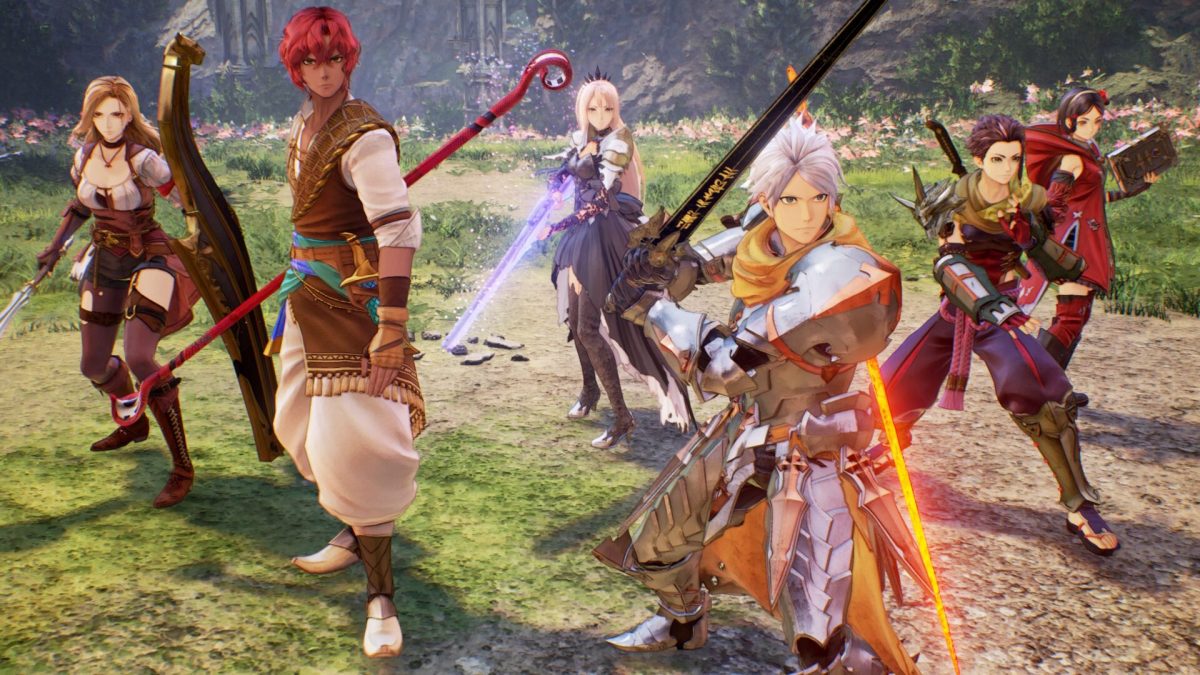Tales of Arise Review on PS5
Tales of Arise is the newest entry in a decades-old JRPG franchise, and as a longtime fan, it sure feels like it — in both positive and negative ways. The callbacks to previous games in the series put a huge smile on my face, while the predictably familiar story beats had me groaning at my screen more than a few times.
Like Final Fantasy, most Tales Of games aren’t connected at all story-wise, even with all the references to other entries. Tales of Arise is one of those isolated games in the series, so newcomers can jump right in without missing anything of importance. But as someone who has played nearly every mainline title since Vesperia in 2008, Tales of Arise feels familiar to the point of being too safe.
The game tells a story of oppression and racial divide between two different groups of people from different planets: the Renans from Rena and the Dahnans from Dahna. Rena conquered Dahna, split the land into five different realms, then proceeded to use Dahnans as slave labor. That’s the backstory, but Tales of Arise starts out well after the initial conflict, 300 years after the first Renan invasion of Dahna.
The two main protagonists are a Dahnan slave named Alphen and a Renan named Shionne, who go on a journey to take down the five Dahnan lords that reign over each of the realms. Alphen is an amnesiac that can’t feel pain; meanwhile, Shionne causes pain to anyone who touches her because of a mysterious power inside her referred to as her “thorns.”
That pain dynamic between Alphen and Shionne comes into play several times throughout the narrative, as the pair goes through often melodramatic situations while warming up to each other. All this while traveling with four other characters — Rinwell, Law, Kisara, and Dohalim — who all want to take down the lords for various personal reasons.

The characters each have their own little quirks that draw you in through relatable and lighthearted moments after everyone comes together to form the party. If this were a family, Rinwell would be the child that reads all day and spouts random facts, Law would be the loud kid who can’t sit still, Kisara would be the overbearing mother, Dohalim the rich uncle, and Shionne the teenager that only leaves their room when they need food.
Alphen feels like the most one-note party member in terms of personality, but thankfully, the others pick up the slack. The way they bounce off each other is great, leading to some genuine laugh-out-loud moments thanks to the topics of conversation and delivery of the voice actors in the dialogue-heavy skits.
Skits are a series staple and they’re back in a way that we’ve never seen before. Instead of floating character portraits or 2D art, the skits are more like mini, partially-animated cutscenes using the 3D models of the characters. They’re still familiar, though, despite the new look. They add nice context to the overall story while also providing some comedic relief as the characters get room to just be themselves in casual conversations about random topics
In fact, party banter found in the skits and during exploration provides some of the best dialogue in the entire game. Shionne is almost always hungry, which makes for some funny running gags throughout the journey, like when other party members are observing a pond and the beauty of the animals in it, she interrupts to ask if they think the fish there are edible. And if any quest has to do with food, Shionne is more involved than she’s ever been.
Some memorable skits also come about when Dohalim still attempts to live like a king even after leaving his royal background behind.
While the party banter leads to standout moments, it can be hard to get attached to the characters emotionally when most of their backstories are given through expositional cutscenes shortly after meeting them. It’s weird to say, but some emotional character moments come too early, just as you’re getting to know the characters.
You don’t spend enough time with some of them before the game thrusts you into their most traumatic moments. A number of the emotional scenes don’t land because of this. Character development comes much later because of the urgency and quick pacing in the main plotline.
The five Renan lords are all vying for power by accumulating a resource called astral energy in objects called Master Cores. To do this, Dahnans are used as slave labor and the astral energy is siphoned from their bodies using items called Spirit Cores, which are grafted onto their skin.
I know that’s a lot of JRPG confusion in one paragraph, but that’s really the simplest way to explain what’s going on at an elementary level. So, rushing through the realms to stop the Renan lords makes sense from a story perspective, especially since most of the party members are Dahnans who want to free their people. But key story beats suffer because of this. They’re either too predictable or they lack any sort of engagement.
The story of two worlds at odds with each other will feel like a serious retread for fans of the franchise, but thankfully, Tales of Arise does actually show some of the darker parts of the Rena/Dahna conflict when it comes to how difficult it is for the Dahnans to live under the rule of the Renans. Though, it feels like there’s a lot of dialogue to paint a much more gruesome picture that can’t be shown because of the Teen ESRB rating.

This story of rebellion involves a lot of fights, and the gameplay adds a few new features to spice things up in ways that series veterans haven’t experienced before. The usual artes and combos are still here, but they’re implemented in ways that combine battle systems from past games in the series while adding unique twists.
In Tales of Arise, artes are special moves that spend part of the AG (Artes Gauge). The AG refills automatically, but it refills faster when you aren’t attacking. Artes can be strung together to create different combos as long as the AG meter isn’t depleted, which is similar to how it works in Tales of Berseria. However, using the same arte multiple times in a combo makes it less effective each time.
On the other hand, the BG (Boost Gauge) fills up faster as you attack and it allows you to perform special moves by calling in a teammate for a unique assist. For instance, Rinwell’s Boost Attack allows her to interrupt enemies that are casting magical artes by stealing the move to use for herself, making it one of the best abilities in the game. Leaning even further into the team synergy features, there are also Boost Strikes. These are essentially flashy tag-team combo attacks. They’re one-hit kill moves that present themselves when enemies have low HP or your combo count is high enough.
Mastering these combat mechanics will get you far in Tales of Arise because there’s a balance between attacking solo and using well-timed party member Boost moves to gain the advantage in fights. The focus on actively using party members to win combat encounters adds a layer of complexity that goes far beyond the button-mashing from previous entries.
With that said, one of the strangest combat choices in the game is the fact that bosses can’t be staggered like normal enemies at all. You can’t get them into hit stun, so they can ignore all of your hits and do whatever they want unless you use specific moves to down them.
For instance, Kisara’s Boost Attack can stop bosses, as they do charge moves. But outside of specific situations like that, you’ll be landing tons of hits that feel like they aren’t doing anything at all. Bosses end up feeling like damage sponges that make your attacks feel weak and unimpactful.
Using Boost Attacks is the only way to interrupt them, but if your BG isn’t full, you might as well be tapping them lightly with your bare hands. Normal attacks feel so empty and pointless in boss encounters, and it can even take a while to stagger regular enemies.
It’s probably for this reason that every character is given a necessary dodge/block move to use in Tales of Arise. The Boost Gauge fills faster when you successfully complete a last-second dodge or block, adding a valuable defensive option to the game.
It’s a nice addition to add a bit more depth to defense, but I wish that it didn’t come at the expense of feeling powerful on offense. It just feels bad to get casually knocked out of a long combo by an enemy that isn’t even flinching when you touch it.

Tales of Arise is a solid entry in the franchise that doesn’t exactly do too much to differentiate itself from its predecessors. The new skits and more team-focused gameplay in combat are certainly welcome changes, but the tale this story tells often feels too similar to others in the past in predictable ways, even though it has its own tough themes regarding racial divides.
The characters are at their best when interacting with each other, providing enough engaging dialogue to make you want to watch skits over some of the more overly dramatic main story cutscenes. The party carries the story on its back, even in the most cliche moments.
All in all, this feels like a safe yet enjoyable follow-up to Berseria. Longtime fans will be satisfied with this entry after the five-year wait since the last mainline game even though Tales of Arise doesn’t feel like it strays too far away from the standard series formula.
- Party banter provides some of the best dialogue in the game.
- Combat is flashy with real depth.
- New skits are a welcome improvement.
- Predictable story beats.
- Bosses feel like damage sponges that can't be staggered.













Updated: Sep 8, 2021 11:54 am